
Why Feral Cats Need More Than Just Kindness
You may have spotted them—those quiet little shadows darting across alleyways or sunbathing in your backyard. Feral cats are part of nearly every neighborhood, living wild but still depending, in small ways, on the kindness of humans.
But what if you could do more than leave a dish of food? What if you could make a real difference in their lives—without even opening your front door?
From clever shelter hacks to community-friendly advocacy, these unexpected ideas go beyond the usual advice and show how simple, thoughtful actions can help feral cats survive—and even thrive—right where they are.
1. Give Feral Cats a Safe Place to Sleep with a Weatherproof Outdoor Shelter


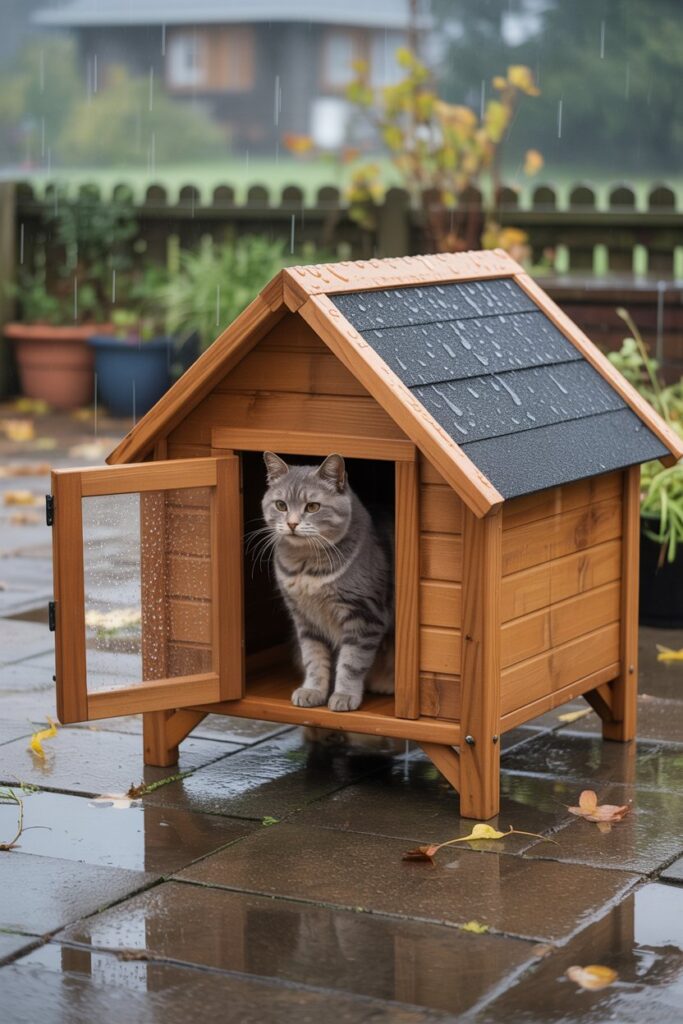
When temperatures drop or summer storms roll in, feral cats need a place to escape the elements. Investing in a weatherproof outdoor cat house gives them more than shelter—it offers security, warmth, and rest.
What Makes a Shelter Actually Work
The best outdoor cat shelters have three non-negotiables: insulation to trap body heat, an elevated floor to prevent ground moisture from seeping in, and a small entrance (6-8 inches) that keeps out larger predators while letting cats slip through safely.
Look for insulated options with waterproof roofing, elevated bases, and removable flaps to block wind. Avoid shelters with multiple large openings—they create drafts that defeat the purpose entirely.
Quick DIY Alternative
If you’re handy, even repurposing old furniture like storage cabinets or coolers can work. The key is ensuring it’s dry, draft-free, and positioned away from wind tunnels. Face the entrance away from prevailing winds (usually north or northwest), and tuck it under an overhang or against a building wall for extra protection.
Placement Pro Tip: Cats prefer shelters they can escape from quickly. Place yours near bushes or fence lines so they have a clear exit route if startled—this single detail can mean the difference between a used shelter and an ignored one.
2. Create a DIY Feeding Station to Keep Food Dry and Accessible

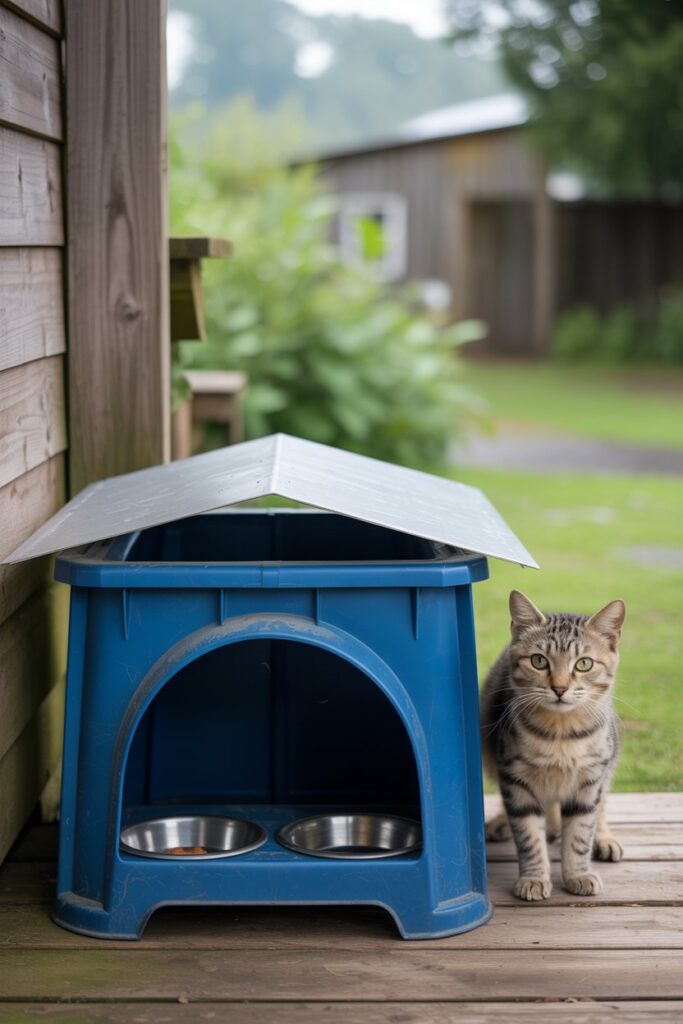
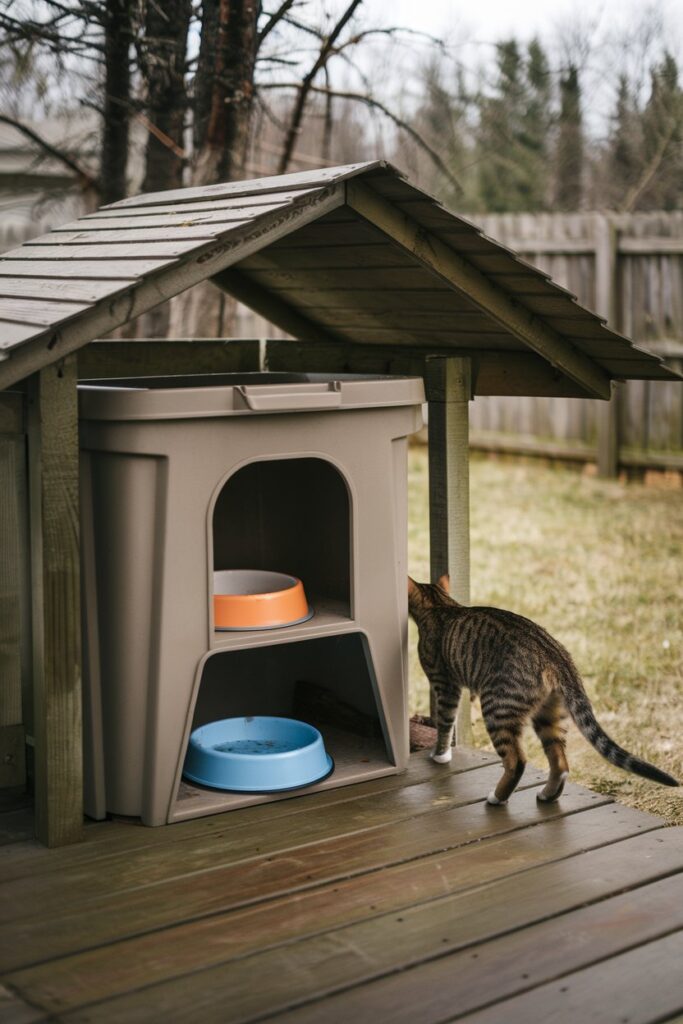

Rain-soaked kibble or snow-covered bowls can discourage even the hungriest cat. Worse, wet food attracts raccoons, possums, and mold—creating health risks for the entire colony. Building a simple feeding station ensures your neighborhood ferals always have a dry, safe place to eat.
The 5-Minute Setup
You can create one using a plastic storage bin (18-gallon works great) with a cut-out entrance on one side and a covered roof that overhangs by 2-3 inches. Cut the entrance about 6 inches wide and 5-6 inches from the bottom—high enough to keep rain from splashing in, but low enough for cats to access easily.
Where to Place It
Position your feeding station in a quiet area that’s easy for cats to find but sheltered from traffic, foot traffic, and predators. Think: under a deck, beside a garage, or behind dense shrubs. Cats eat faster when they feel safe, so visibility from multiple angles matters.
Feeding Schedule Hack: Stick to the same time daily (dawn and dusk work best). Feral cats learn routines quickly, and consistency means less food waste and fewer pest problems. Pick up uneaten food after 30 minutes to keep the area clean. A reliable feeding spot encourages routine and shows the cats they’re cared for—even from afar.
Make sure to avoid these 8 common errors when feeding stray cats>>
3. Offer Clean, Unfrozen Water—Even in the Cold
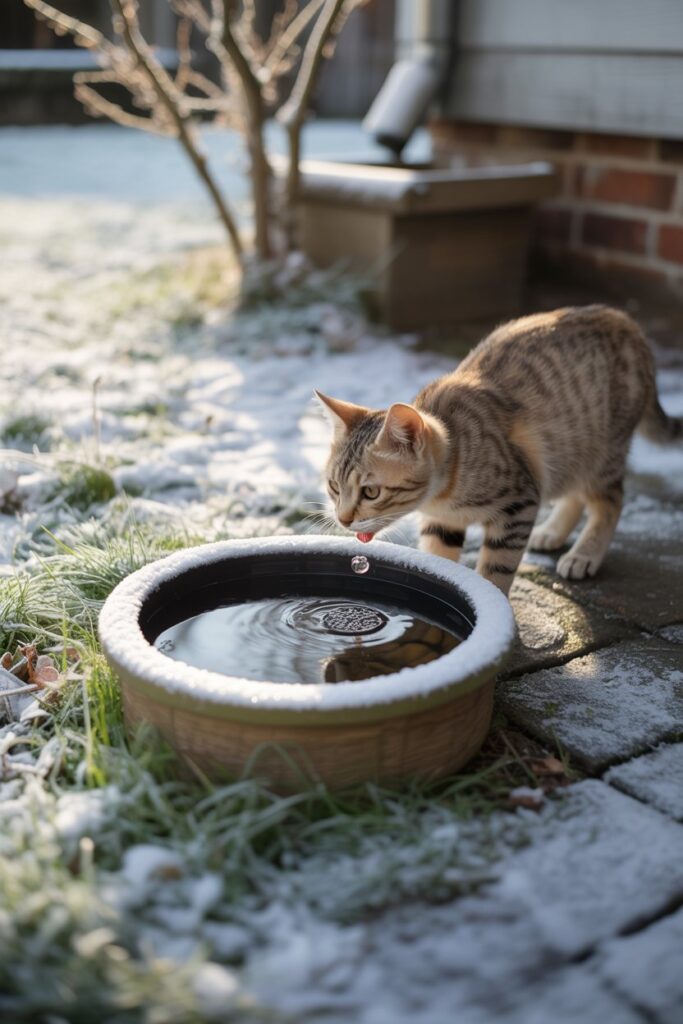


Access to fresh water is just as important as food—but during winter, that’s easier said than done. Outdoor water bowls can freeze in under an hour when temperatures drop below 32°F, leaving feral cats without hydration for hours or even days.
Why This Matters More Than You Think
Dehydrated cats eat less, have weakened immune systems, and struggle to maintain body heat. In extreme cold, they’ll eat snow—which actually lowers their core temperature and burns precious calories.
3 Quick Solutions That Actually Work
- Solar placement: Position dark-colored bowls in direct sunlight against a south-facing wall. Dark colors absorb heat and can delay freezing by 2-3 hours.
- Insulated water stations: Nestle a smaller bowl inside a larger one with insulation (crumpled newspaper or foam) between them. Add a styrofoam lid with a cat-sized opening.
- Heated water bowls: Battery-powered or plug-in heated dishes (under $25) keep water at 40-50°F—just warm enough to stay liquid without burning paws.
The Budget Hack: Can’t afford heated bowls? Swap water 2-3 times daily during freezing temps. Morning, midday, and evening checks take 5 minutes total but make a massive difference.
4. Support Trap-Neuter-Return (TNR) Programs in Your Area

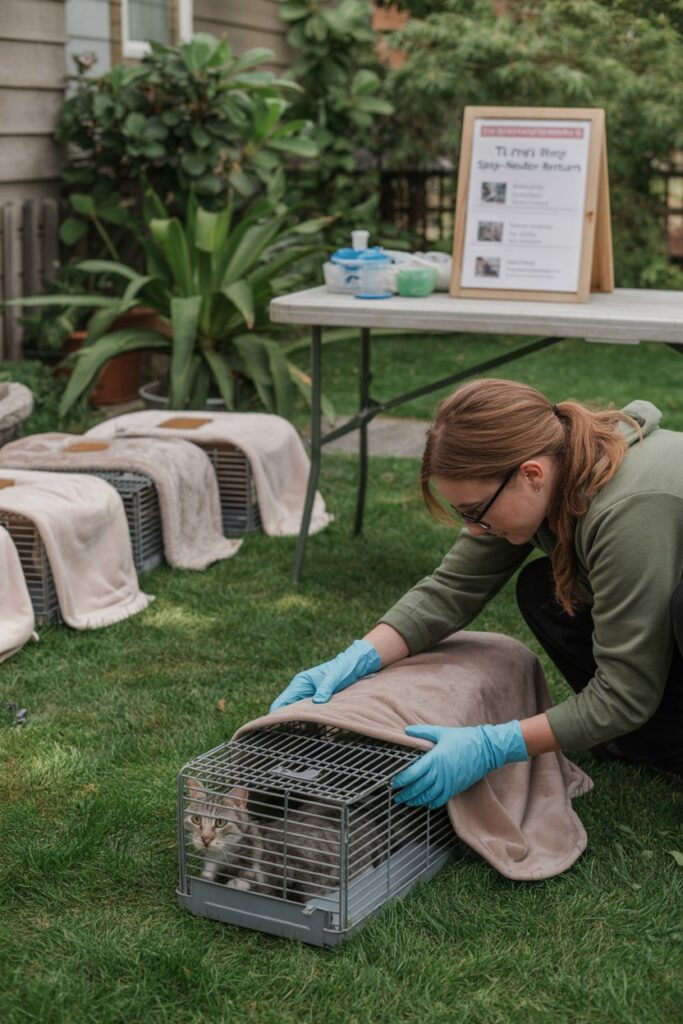
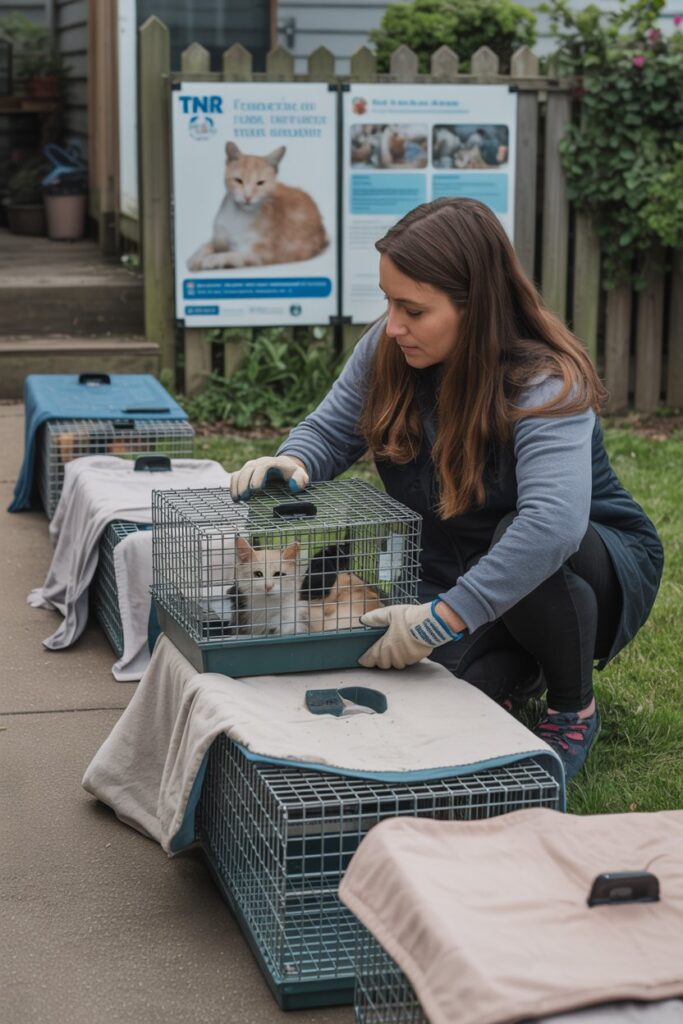
One of the most impactful things you can do for feral cats is to support or participate in a Trap-Neuter-Return (TNR) program. These humane initiatives stop the endless cycle of kitten births and reduce neighborhood tension over cat colonies.
The Real Impact of TNR
One unspayed female cat can produce 180 kittens in her lifetime when you factor in her offspring’s reproduction. TNR breaks this cycle permanently—sterilized cats can’t reproduce, colony sizes stabilize, and behaviors like yowling and fighting decrease dramatically.
How to Help (Even If You Can’t Trap)
Many local rescues or animal control groups run TNR operations. Here’s how you can contribute without handling traps:
- Donate supplies: Traps cost $40-60 each; wet food for baiting; recovery crates
- Volunteer transport: Drive trapped cats to/from vet appointments
- Spread the word: Share TNR resources on neighborhood apps like Nextdoor
- Sponsor a cat: Many programs let you cover spay/neuter costs ($30-75 per cat)
Finding Programs Near You: Search “[your city] TNR program” or “[your zip code] feral cat spay neuter.” Alley Cat Allies has a searchable database at alleycat.org/resources.
5. Use Straw, Not Blankets, to Keep Outdoor Cat Shelters Warm
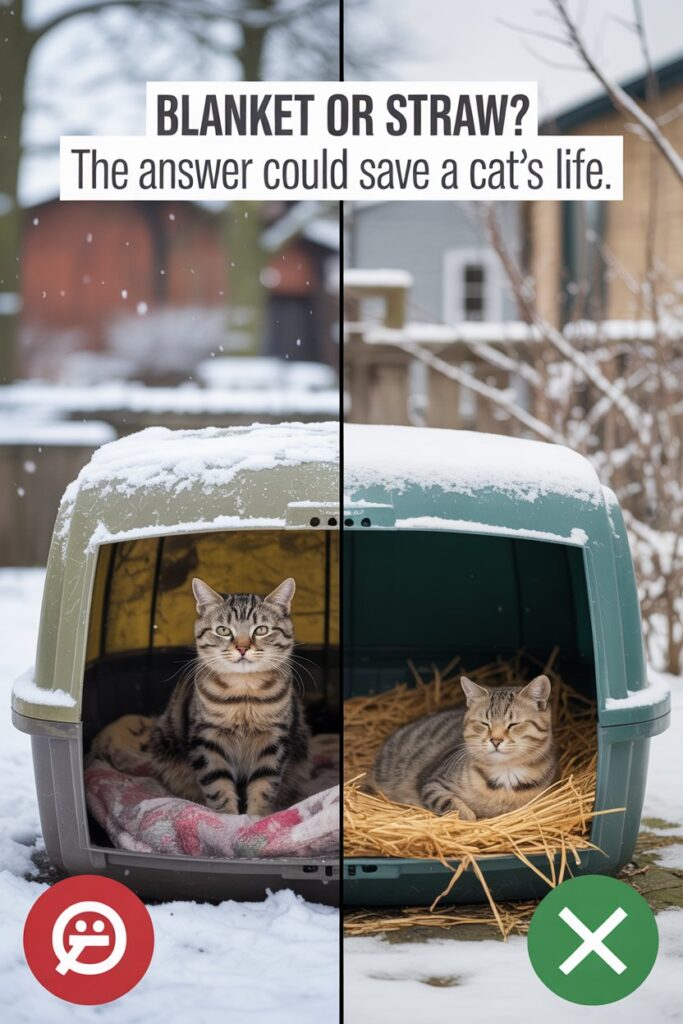
It might seem cozy to add an old towel or blanket to your outdoor cat house—but that’s actually a common mistake that can turn deadly. Fabric absorbs moisture from snow, rain, and even cat breath, which makes the shelter colder and creates a hypothermia risk in winter.
Why Straw Works (And Fabric Fails)
Straw is hollow and tubular, which traps warm air and repels moisture naturally. When a cat burrows into it, their body heat gets trapped in the air pockets—creating a self-warming nest. Wet blankets do the opposite: they pull heat away from the cat’s body.
Straw vs. Hay—There’s a Big Difference
- Straw = dried stalks (golden, hollow, no seed heads) ✅
- Hay = dried grass with seeds (greenish, holds moisture, molds easily) ❌
You can find straw at farm supply stores, garden centers, or pet stores. One bale ($5-10) is enough for multiple shelters and lasts all winter.
How Much to Use: Fill the shelter 6-8 inches deep. Cats will compress it into a cozy nest shape themselves. Replace it mid-winter if it gets matted or damp. This small change makes a huge difference in keeping feral cats dry, warm, and safe through the coldest months.
6. Educate Neighbors About Feral Cat Myths and Misconceptions

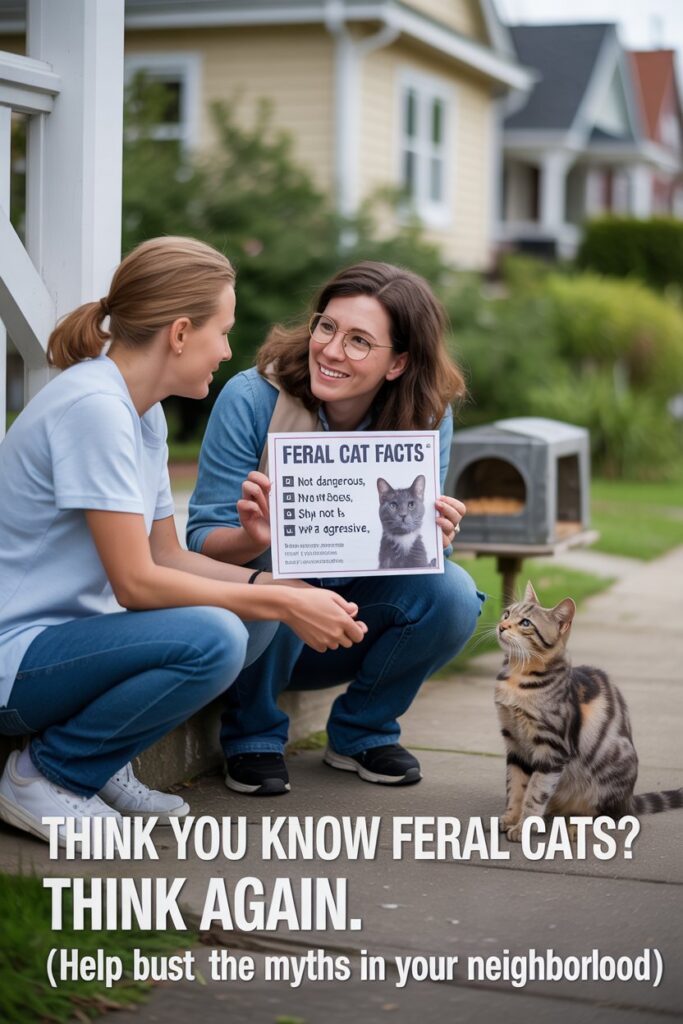
Many people misunderstand feral cats—believing they’re dangerous, diseased, or simply unwanted nuisances. In reality, most are shy, non-aggressive animals that simply want to live quietly and avoid trouble.
The Truth About Common Myths
Myth #1: “Feral cats spread diseases to humans.”
The reality: Feral cats have similar disease rates to pet cats, and rabies in cats is extremely rare (under 1% of cases). They’re actually more likely to avoid humans entirely.
Myth #2: “They’re destroying the bird population.”
The reality: Habitat loss, glass windows, and climate change are far bigger threats. Well-fed TNR colonies hunt less, and studies show managed colonies stabilize local ecosystems.
Myth #3: “Feeding them makes the problem worse.”
The reality: Feeding doesn’t cause reproduction—lack of spaying/neutering does. Fed cats are healthier, easier to TNR, and less likely to roam into traffic or neighbors’ yards.
How to Be an Effective Advocate
You can help by sharing accurate information with neighbors, gently correcting false assumptions when they come up, and promoting the benefits of TNR and humane care. The calmer and more fact-based your approach, the more receptive people will be.
Try This: Print simple one-page flyers explaining your neighborhood TNR program and post them in community spaces. Include: what TNR is, why it works, and how it benefits everyone (reduced noise, stable colony size, healthier cats).
7. Plant Cat-Friendly Shrubs or Ground Cover for Natural Shelter

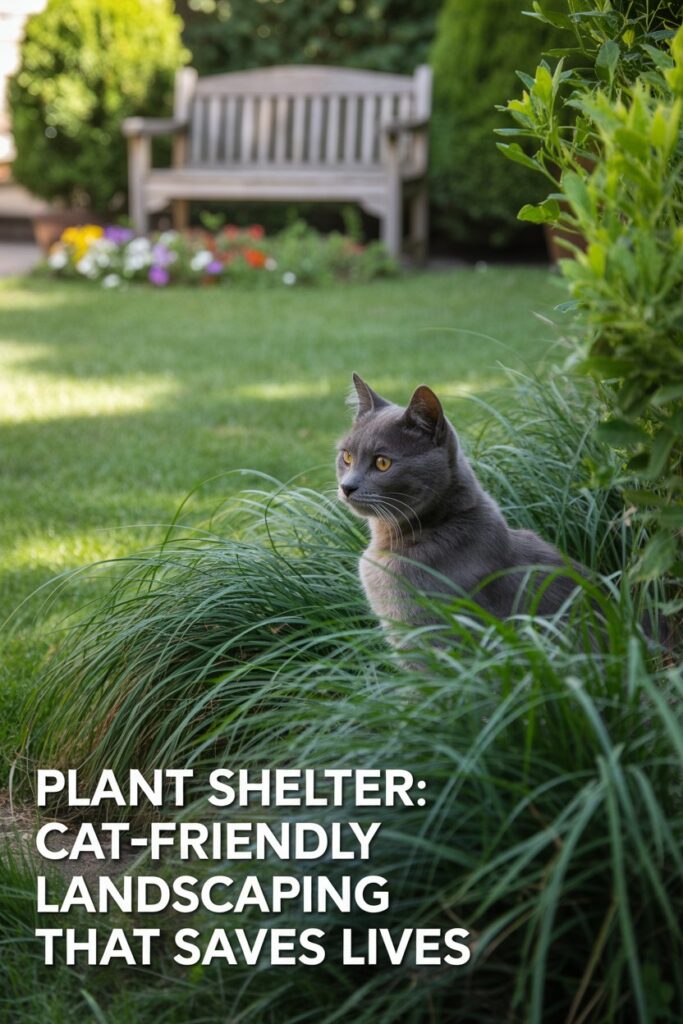
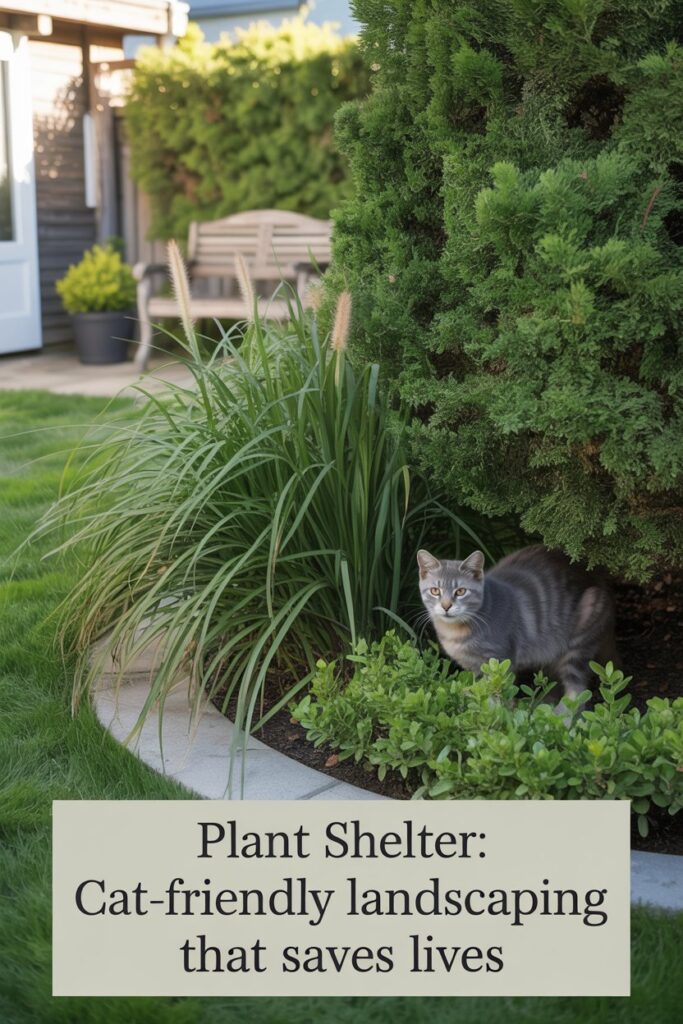
Feral cats instinctively seek out quiet, hidden areas where they can stay safe from predators, people, and the elements. Creating natural cover in your yard gives them a secure retreat that blends seamlessly into the environment—no extra structure required.
Why It Matters
Natural shelter helps cats regulate temperature and avoid stress. Dense plantings also reduce noise and visual exposure, helping them feel safer and calmer.
Best Plant Choices (Low-Maintenance and Safe)
- Year-round cover: Boxwoods, junipers, or hollies provide evergreen protection.
- Soft hiding spots: Tall ornamental grasses like switchgrass, fountain grass, or miscanthus create warm, movable cover.
- Ground protection: Native plants like catmint, creeping thyme, or pachysandra offer shade and camouflage.
Pro Tip: Avoid toxic plants like lilies, azaleas, or oleander. Choose native species whenever possible—they support local pollinators and adapt better to your region. Even a few shrubs or tall grasses along a fence line can make your yard a safer, more inviting haven for outdoor cats—without changing its look or maintenance needs.
8. Build a Winter Shelter from a Storage Bin or Cooler
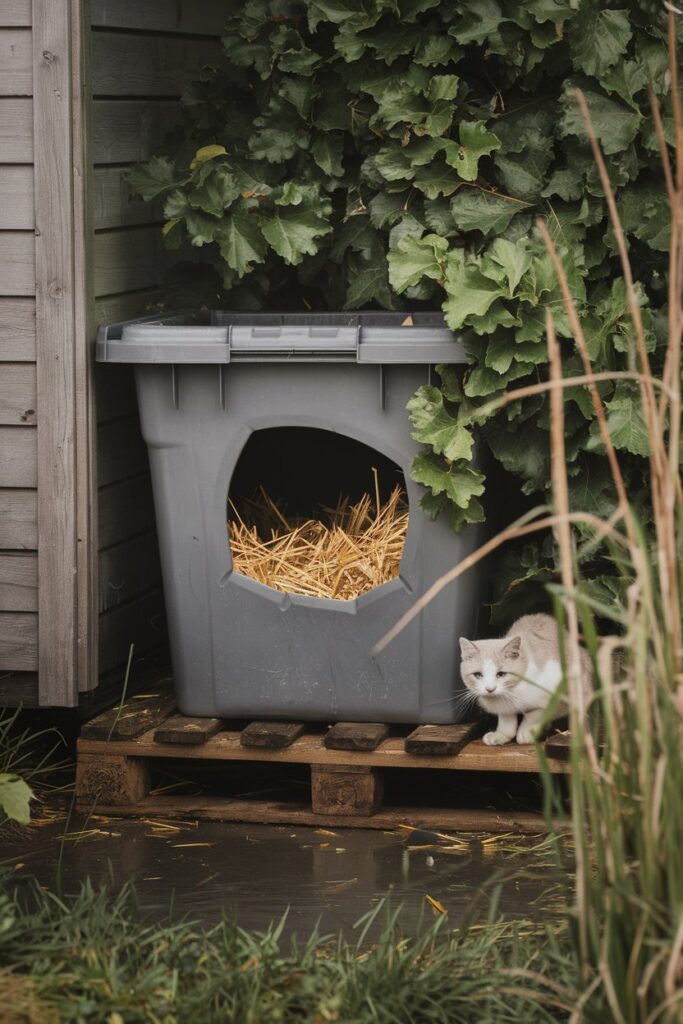
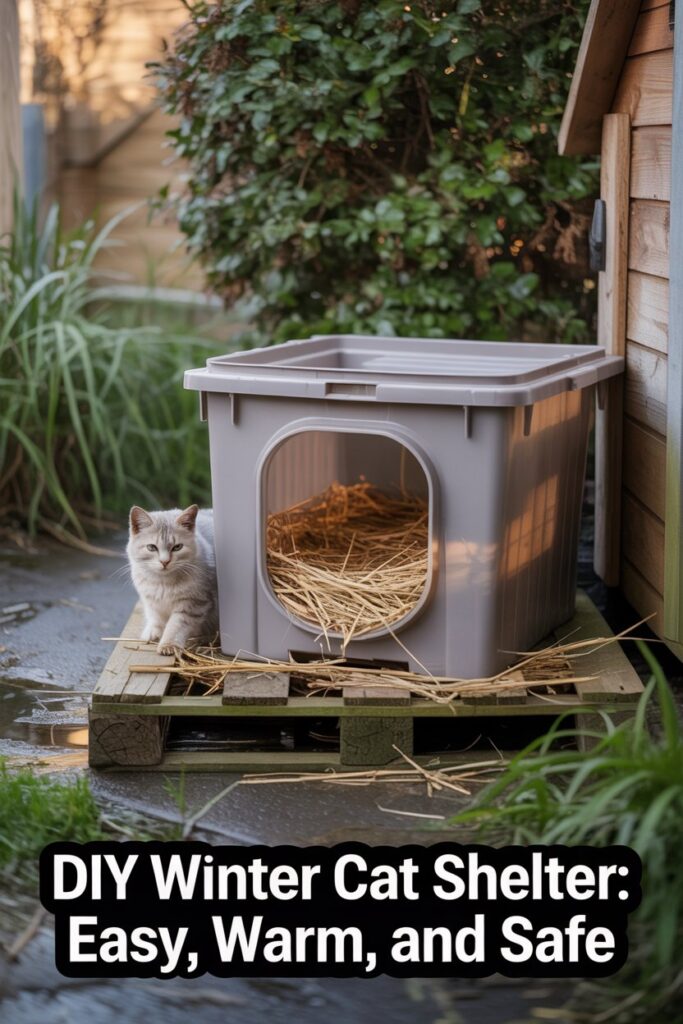

When temperatures drop, a simple DIY shelter can mean the difference between comfort and survival for feral cats. You don’t need expensive materials—just a sturdy plastic bin, some insulation, and a bit of time.
How to Build It
- Cut a 6–8 inch round hole on one side (large enough for a cat, too small for predators).
- Line the inside with foam insulation or straw (not hay or fabric).
- Seal the lid tightly and elevate the shelter off the ground using bricks or wood blocks.
- Angle the entrance away from prevailing winds and rain.
Placement Tips
Tuck the shelter in a quiet, discreet area—under a deck, behind a shed, or near shrubs. Grouping two or three together can help cats share warmth without overcrowding.
Maintenance
Check monthly for moisture or debris and replace straw mid-season. One weekend project can save multiple cats from freezing nights.
For the ultimate guide to building DIY cat shelters for outdoor cats, check this out>>
9. Donate Supplies to Local Feral Cat Caretakers or Rescues

If you can’t personally care for feral cats, supporting those who do is just as impactful. Local caretakers and small rescues often fund colony care out of pocket.
What They Usually Need Most
- Canned and dry cat food (unopened, non-expired)
- Straw or insulation materials
- Plastic bins or coolers for DIY shelters
- Pet-safe heating pads or water bowl warmers
- Gift cards for local pet or farm supply stores
How to Help Effectively
Before donating, contact a local rescue or TNR group to see what’s in short supply. Many share Amazon or Chewy wish lists for convenience. A small contribution—like a $20 bag of food—can sustain several cats for a week.
When you give, you’re not just donating supplies—you’re giving warmth, nutrition, and comfort to animals who rely on human kindness to survive.
10. Foster or Socialize Young Feral Kittens When Possible

Adult feral cats rarely adapt to indoor life, but kittens under 8 weeks old still can. Early human contact can completely change their future—from surviving outside to thriving as loving pets.
What to Do If You Find Feral Kittens
- Observe first—make sure the mother isn’t nearby before intervening.
- Contact a local rescue or TNR group for guidance; many have foster networks ready to help.
- If fostering, start in a quiet, confined space and use slow, gentle handling with food-based positive reinforcement.
Each socialized kitten reduces future colony growth and adds one more companion to a loving home. Fostering is more than rescue—it’s prevention. A little care today can change an entire cat community tomorrow.
Winter vs Summer Feral Cat Care Checklist
Seasons change how outdoor cats survive. Use this quick side-by-side guide to adapt feeding, water, and shelter care so colonies stay safe all year long.
❄️ Winter Care Cold, wet, windy
-
✓
Insulate shelters with straw (not blankets or hay). Keep entry small; face away from wind and elevate off the ground.
-
✓
Use heated or insulated water bowls and refresh often to prevent freezing; place in sun where possible.
-
✓
Feed on a schedule (slightly higher calories). Offer calorie-dense wet food during warmer daylight hours.
-
!
Avoid fabric bedding—it traps moisture and increases hypothermia risk.
-
✓
Weatherproof entrances with vinyl flaps or tunnel extensions to block drafts.
💡 Pro tip: Replace straw mid-season if it mats or gets damp. Clear snow from access paths after storms.
☀️ Summer Care Heat, sun, storms
-
✓
Prioritize shade & airflow: place shelters under shrubs or trees; add small ventilation holes covered from rain.
-
✓
Multiple water stations in shaded spots; use wide, shallow bowls and refresh twice daily to keep cool and clean.
-
✓
Feed smaller portions more often to reduce spoilage; pick up leftovers within 30–45 minutes.
-
!
Avoid sealed plastic boxes in full sun—they can overheat quickly. Choose light colors and indirect light.
-
✓
Landscape for cover: evergreen shrubs and tall grasses create cool hideaways and storm refuge.
💡 Pro tip: Replace water twice daily and provide shaded areas with airflow. Use light-colored shelters to reduce heat buildup.
Common Problems (and How to Solve Them)
Even the most thoughtful feral cat setup can run into challenges. Whether cats aren’t showing up or neighbors start asking questions, small tweaks can make a big difference. Here’s how to handle the most common issues humanely and effectively.
1. What if cats won’t use the shelter?
Don’t worry—it’s normal for feral cats to take time before trusting anything new in their territory. Start by placing the shelter in a quiet, low-traffic area with multiple escape routes.
Sprinkle a little catnip, silvervine, or a familiar blanket inside to make it smell inviting. Avoid strong new materials or bright colors; cats prefer neutral tones that blend with their surroundings. If possible, camouflage the shelter with shrubs or fencing so it feels safer. Once one cat uses it, others will usually follow.
2. What if neighbors complain about the cats?
Many concerns stem from misunderstanding. Calmly explain that you’re supporting a humane solution, not creating a problem. Trap-Neuter-Return (TNR) programs actually reduce noise, odor, and territorial behavior by preventing mating. Share reputable resources from the ASPCA or Alley Cat Allies to show how managed colonies stabilize over time.
If tension persists, try compromise solutions—move feeding areas out of sight, keep food stations tidy, and ensure bowls are picked up after feeding hours to avoid attracting wildlife. Visible organization signals responsibility, which often wins people over.
3. What if other animals eat the food?
You can discourage raccoons, opossums, and skunks with a few adjustments.
- Feed during daylight or early evening (feral cats adjust faster than nocturnal visitors).
- Use feeding stations with smaller entry holes or PVC “tunnels” that only cats can squeeze through.
- Elevate the feeding platform a few inches off the ground and keep it clean.
- Sprinkle a bit of citrus peel or peppermint oil nearby—both repel wildlife but don’t bother cats.
4. What if cats fight at the feeding station?
Tension often happens when space or food feels scarce. The fix is simple: create more “zones.” Place two or three smaller feeding areas several feet apart rather than one large one. This allows timid cats to eat without confrontation.
Also, feed slightly more than needed—competition drops when food is plentiful. Over time, the colony establishes its own peaceful hierarchy. If aggression continues, observe from a distance to identify dominant cats and stagger their feeding times.
Fact: Helping feral cats isn’t always smooth—but every problem has a compassionate, practical solution. The goal isn’t perfection; it’s progress. With patience, clear communication, and small adjustments, you’ll build trust with both the cats and your community
How Pet Lovers Can Create a Safer World for Feral Cats
Helping feral cats doesn’t always require big resources or huge commitments. Sometimes, it’s as simple as building a shelter from a bin, sharing the truth with a neighbor, or offering a warm bowl of food on a cold morning.
At Sweet Purrfection, we’re more than just pet lovers—we’re a community passionate about thoughtful ideas that make life better for animals and their humans. From outdoor cat houses to everyday inspiration, we’re here to help you show compassion in creative ways.
Together, we can make every neighborhood a little more welcoming—for every whiskered wanderer that calls it home.
Meet Sean, a fintech whiz with a penchant for pet purrs and blockchain buzz. After a decade of fintech feats, Sean’s tech talents leaped from ledger lines to litter lines, driven by a passion for pets and a vision for a more connected pet care community. With three critter companions as co-pilots, Sean launched this blog to share a treasury of pet-friendly tech tips and tales.

